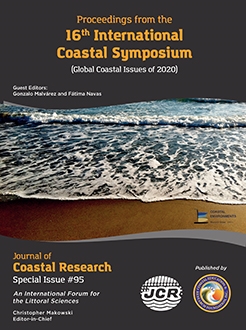Rohmer, J.; Louisor, J.; Le Cozannet, G.; Naveau, P.; Thao, S., and Bertin, X., 2020. Attribution of extreme wave height records along the North Atlantic coasts using hindcast data: Feasibility and limitations. In: Malvárez, G. and Navas, F. (eds.), Global Coastal Issues of 2020. Journal of Coastal Research, Special Issue No. 95, pp. 1268-1272. Coconut Creek (Florida), ISSN 0749-0208.
Extreme Event Attribution (EEA) aims at answering questions about how much climate change influenced the probability or intensity of a specific type of extreme meteo-oceanic event. Here, we focus on wave record breaking i.e. the occurrence of an extreme significant wave height (hs) value that exceeds all past observations. The objective is to evaluate the probability changes related to climate change by estimating the fraction of attributable risk far=1–p0/p1, where p0 and p1 are probabilities of the wave record event in two different worlds: a counterfactual world without anthropogenic forcings i.e. a “world that might have been”, and the factual world, i.e. “world that is.” To define these different worlds, we rely on a wave hindcast database, which provides very long time series (1900-2008) of hs over the whole North Atlantic Ocean Basin (NAOB). We assume that the counterfactual world corresponds to the series of annual hs maxima over the period 1900-1930, and that the factual world corresponds to the annual hs maxima over the period 1978-2008. The extreme event attribution approach dedicated to record breakings was applied over NAOB, and we show large far values (>0.5) along the northern Canadian, Scottish and southwestern Norwegian coasts (over the latitudes 50°-65°N). These results are, however, carefully discussed with respect to different uncertainty sources, namely the validity of the assumptions underlying the EEA, the statistical uncertainties, the use of hindcast data instead of global climate model's results, and the limitations in the hindcast database setup.





